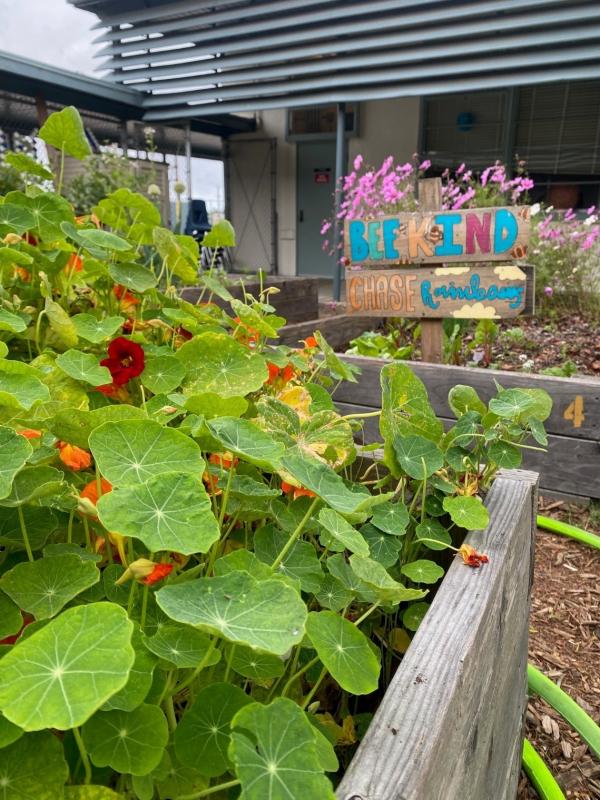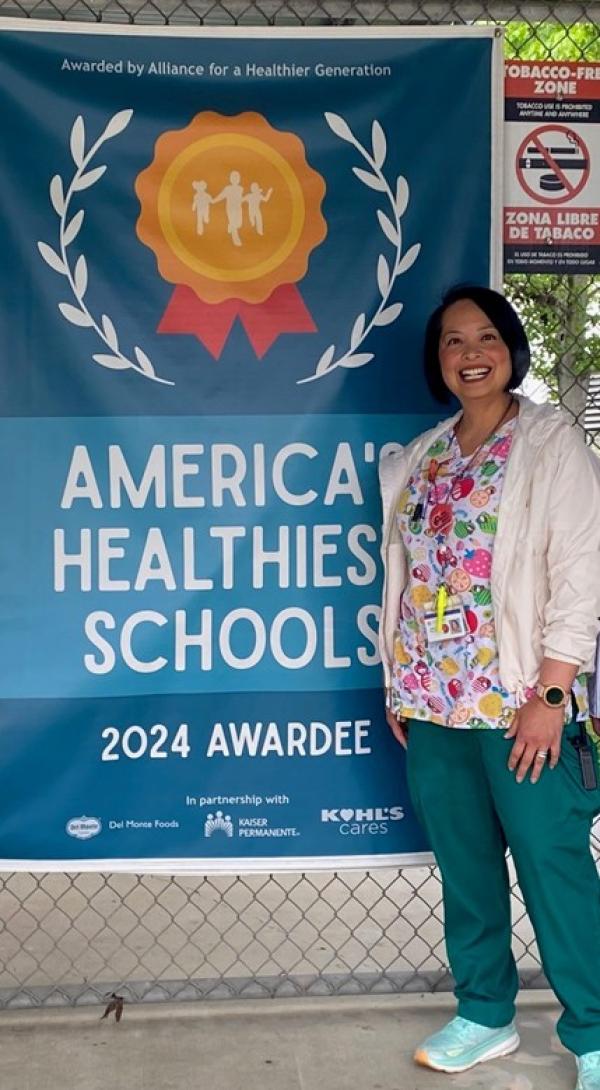June 18, 2025
Field Elementary Engages Students with an Accessible School Garden in San Diego
Learn how Field Elementary created an inclusive garden to cultivate nutrition education and food access.
School gardens can bolster science education, encourage physical activity, and support nutrition and food access. At Field Elementary in San Diego, CA, students and staff are experiencing these benefits firsthand as they cultivate an accessible school garden.
School Nurse Juliet dela Paz, RN, MSN, explains how Field, one of America’s Healthiest Schools, has created an inclusive space that welcomes all students, and shares tips for other schools that would like to do the same.
Q: How did Field Elementary start the school garden, and who was involved?
A: The “Field of Greens” garden began as a literal “seed” of an idea. It all started in our classrooms, where students reused cereal containers from their breakfast meals to create mini microgreen gardens on their windowsills. Each student filled their container with soil, planted seeds, and eagerly watched their greens sprout and grow. This hands-on, sustainable activity not only taught students about the plant life cycle but also encouraged recycling and environmental awareness.
When it came time to harvest their microgreens, we celebrated with a classroom “salad party.” Each classroom received fresh lettuce, chopped vegetables, and a splash of dressing to create their own salad creations. Students, staff, and families joined in the fun, and the excitement was amazing. That event sparked something bigger. It became clear: we needed a school garden — a true “Field of Greens”—right here at Field.
Driven by that first “harvest,” a team of garden-loving parents, staff, and students came together to turn the idea into reality. They researched what it would take to build a full-scale garden and partnered with the San Diego Master Gardeners Association to construct garden beds on campus. On several Saturdays, folks brought their tools and shovels and build the Garden beds and irrigation systems. We also worked with our district’s Physical Plant Operations to make sure everything was within “specs.”
Over time, the garden continued to grow — literally and figuratively. With support from the SAY San Diego Program and a grant from the Sage Garden Project, “Field of Greens” has flourished into a thriving outdoor learning space. Today, it serves as a hub for hands-on science education, healthy eating initiatives, and community engagement.
“If you build it, it will grow!” That simple belief planted the roots of something extraordinary. What began as recycled cereal containers and curious hands has blossomed into a sustainable, enriching program that continues to nurture both plants and young minds."
Q: How do you design and maintain a garden that’s accessible and engaging for young people, particularly students who are neurodivergent or have disabilities?
The “America’s Healthiest Schools” banner is something we proudly display right out front—it’s a big deal for us! But if there’s one thing that really shows what that banner stands for, it’s our “Field of Greens” garden. It’s become a true centerpiece of our school, both literally and figuratively.
Thanks to the support of our amazing Field PTA and the Sage Garden Grant, we’ve been able to offer gardening and culinary classes to students throughout the school year. The kids get their hands dirty learning about things like vermiculture (yep, worms!), and they even make colorful rainbow sushi rolls using the very greens they’ve grown themselves. Just yesterday, students were out harvesting sweet pea flowers and lavender while learning about aromatherapy and mindfulness—it’s been beautiful to watch.
Speaking of sweet peas, there’s one moment I’ll never forget. We have a student with multiple, severe food allergies. One day, while walking around campus, I saw her carefully picking sweet peas from the garden. She was smiling, totally at ease. I got emotional because in that moment, she was able to enjoy a healthy snack without worry. No label to read, no fear of cross-contamination, no anxiety — just fresh, safe food straight from the plant. That’s powerful.
We’ve made sure the garden is inclusive, too. For our students with disabilities, we’ve created rolling garden beds made from recycled salad bars (shout out to the district for that idea!). These can be moved right up to students in wheelchairs, making it possible for everyone to be part of the experience.
"The Field of Greens is more than just a garden — it’s a calm, welcoming space. We’ve added benches and stools so anyone can take a moment to relax, reset, or just enjoy being surrounded by nature. Whether it's for a lesson, a snack, or a little peace and quiet, the garden is here for everyone."
Q: What’s growing this year, and what’s exciting students in the garden?
A: Right now, our Field of Greens Garden is not only growing — it’s thriving with character and creativity! One of our most beloved residents is a massive rhubarb plant that I’ve affectionately named Barbara.
Around her, we’ve got sweet peas and lavender blooming, filling the space with soft color and calming scents. There’s also milkweed, planted to welcome Monarch butterflies and support local pollinators — our garden doubles as a habitat and a science lab!
To add even more charm, our students have painted wooden signs to decorate the garden beds. Each one is unique and full of personality, just like the kids who made them. These signs bring pops of color, creativity, and ownership into the space — truly making it their garden.
"The Field of Greens is a space that grows more than just plants — it grows joy, pride, and community."
Q. Do you have any advice for schools who want to make their outdoor activities and spaces more inclusive and accessible?
A: Yes! One of the best things you can do is to make your garden or outdoor space a true centerpiece of the school—something everyone feels connected to. When you design it with all students, staff, and families in mind, you naturally create a more inclusive and accessible environment.
Start by looking at what you already have. Resources are all around you! Old materials like salad bars can become garden beds, and unused corners of campus can be transformed into peaceful, purposeful spaces. Tap into your community —parents, local organizations, and even your own school staff often have hidden talents or connections that can make a huge difference.
But honestly, the biggest resource is your people. When you bring together a group that’s committed to health, well-being, and equity, amazing things can happen. Include voices from across your school community — especially those who might be impacted by accessibility challenges — and work together to create spaces where everyone can learn, grow, and feel at home.
Q: How does gardening benefit student and staff health and learning at Field Elementary?
A: The Field of Greens reminds us that if we build it, it will grow — and that’s exactly what happened. What began as a tiny “seedling” of an idea has blossomed into the vibrant, thriving garden we know and love today. It’s a perfect example of how a small spark can lead to something much bigger when nurtured by a passionate community.
Sustainability is at the core of what every wellness coordinator hopes to achieve with health and wellness initiatives, and this is one seed we’ve truly been able to harvest. From student-grown greens to inclusive design and community partnerships, Field of Greens is a living, growing reminder that when we plant with purpose, beautiful things take root.
See more nutrition and accessibility resources:
Mapping Resources to Support District Nutrition and Food Access | En Español
Nourishing Futures: An Exploration of Urban Agriculture
Explore New Foods & Flavors | En Español
Six Ways to Make Your Home Accessible and Inclusive for Young People with Disabilities
-By Kohleun Adamson




